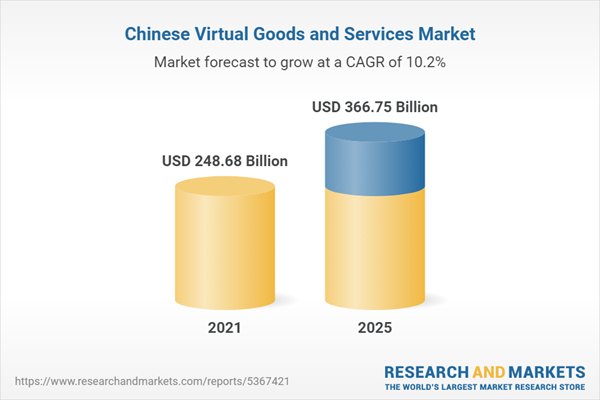This report provides an in-depth analysis of the virtual goods and services market in China including a detailed description of market sizing and growth. The report provides an analysis of China's virtual goods and services market by value, by industry and includes segment analysis as well.
Moreover, the report also assesses the key opportunities in the market and outlines the factors that are and will be driving the growth of the industry. The growth of China's virtual goods and services market has also been forecasted for the period spanning 2021-2025, taking into consideration the previous growth patterns, the growth drivers and the current and future trends.
The major players dominating the virtual goods and services market in China are Fulu Holdings Limited, Tencent Holdings Limited, Kaixin001, and iQIYI, Inc. The four companies have been profiled in the report providing their business overview, financial overview and business strategies.
Country Coverage
- China
Company Coverage
- Fulu Holdings Limited
- Tencent Holdings Limited
- Kaixin001
- iQIYI, Inc.
Table of Contents
1. Executive Summary
Samples

LOADING...
Executive Summary
Virtual goods and services refer to non-physical objects and services exchanged in the virtual or non-physical realm. Virtual goods include e-vouchers, in-game virtual currencies and items, accounts, gift cards, membership cards and coupons, which can be exchanged for products and services offered by virtual goods vendors. The first virtual goods can be traced back to early multi-user dimension video games. The major characteristics of virtual goods are: originally digital; only consumable online; individual ownership; unique; and context-bound.
Third-party virtual goods and services platform operators are platforms that connect virtual goods vendors and virtual goods sales channels. Third-party virtual goods and services platform operators typically offer both virtual goods-related services and value-added services, such as online sales platform setting-up, online store operations and marketing and IT services.
The virtual goods and services market can be categorized into four segments in China: Leisure and Entertainment, Games, Telecommunications, and Lifestyle Services.
China virtual goods and services market has increased at a significant CAGR during the years 2016-2020 and is projected to grow even further during the forecast period (2021-2025). The market is expected to be driven by various growth enhancing factors such as the development of China’s online pan-entertainment industry, growth of China’s economy and consumption, increasing penetration of mobile payments, growing urban population, increasing internet usage, rising young consumer base, etc. However, the market is not free from challenges that are hindering its growth. Some of the major challenges faced by the market are entry barriers, privacy, security, and legal threats, regulatory risks, working capital requirements, etc.
Companies Mentioned
- Fulu Holdings Limited
- Tencent Holdings Limited
- Kaixin001
- iQIYI, Inc.
Table Information
| Report Attribute | Details |
|---|---|
| No. of Pages | 71 |
| Published | July 2021 |
| Forecast Period | 2021 - 2025 |
| Estimated Market Value ( USD | $ 248.68 Billion |
| Forecasted Market Value ( USD | $ 366.75 Billion |
| Compound Annual Growth Rate | 10.2% |
| Regions Covered | China |
| No. of Companies Mentioned | 4 |









